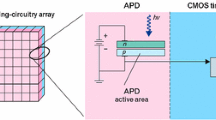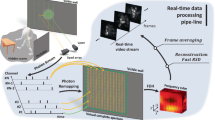Abstract
Although time-of-flight (ToF) cameras are becoming the sensor-of-choice for numerous 3D imaging applications in robotics, augmented reality (AR) and human-computer interfaces (HCI), they do not explicitly consider scene or camera motion. Consequently, current ToF cameras do not provide 3D motion information, and the estimated depth and intensity often suffer from significant motion artifacts in dynamic scenes. In this paper, we propose a novel ToF imaging method for dynamic scenes, with the goal of simultaneously estimating 3D geometry, intensity, and 3D motion using a single indirect ToF (I-ToF) camera. Our key observation is that we can estimate 3D motion, as well as motion artifact-free depth and intensity by designing optical-flow-like algorithms that operate on coded correlation images captured by an I-ToF camera. Through the integration of a multi-frequency I-ToF approach with burst imaging, we demonstrate high-quality all-in-one (3D geometry, intensity, 3D motion) imaging even in challenging low signal-to-noise ratio scenarios. We show the effectiveness of our approach through thorough simulations and real experiments conducted across a wide range of motion and imaging scenarios, including indoor and outdoor dynamic scenes.
R. J. Suess—Independent Reseracher.
Access this chapter
Tax calculation will be finalised at checkout
Purchases are for personal use only
Similar content being viewed by others
Notes
- 1.
A short integration time is also required for instantaneous motion estimation.
- 2.
We assume a unipolar demodulation function \(\left( 0 \le D(t) \le 1 \right) \) for ease of noise analysis. The same analysis can be extended to a bipolar demodulation function \(\left( -1 \le D(t) \le 1 \right) \). See the supplementary report.
- 3.
We assume \(Z\ne 0\).
- 4.
Most I-ToF cameras provide a temporal stream of the correlation image sets.
- 5.
Due to motion, the absolute value of the estimated intensity image does not preserve its brightness even along the true motion. See the supplementary report.
- 6.
The intensity image I records the signal photons, while the image used in traditional optical flow records the background photons (e.g., sunlight reflected from the scene).
- 7.
We simulated velocity estimation from depth difference and Doppler ToF under Poisson noise. \(\sigma _{v_{\varDelta z}}\) and \(\sigma _{v_{\varDelta f}}\) were computed from 1000 repetitions.
References
http://www.ignorancia.org/index.php?page=lightsys. Accessed 14 July 2024
http://www.povray.org/. Accessed 14 July 2024
3d depth sensing development kits, pmd. https://3d.pmdtec.com/en/3d-cameras/flexx2/. Accessed 14 July 2024
Azure kinect dk, microsoft. https://www.microsoft.com/en-us/d/azure-kinect-dk/8pp5vxmd9nhq?activetab=pivot:overviewtab. Accessed 14 July 2024
Time-of-flight sensors, texas instruments. https://www.ti.com/sensors/specialty-sensors/time-of-flight/products.html. Accessed 14 July 2024
Agresti, G., Schaefer, H., Sartor, P., Zanuttigh, P.: Unsupervised domain adaptation for tof data denoising with adversarial learning. In: Proceedings of the IEEE/CVF Conference on Computer Vision and Pattern Recognition, pp. 5584–5593 (2019)
Agresti, G., Zanuttigh, P.: Deep learning for multi-path error removal in tof sensors. In: Proceedings of the European Conference on Computer Vision (ECCV) Workshops, pp. 0–0 (2018)
Attal, B., et al.: Törf: time-of-flight radiance fields for dynamic scene view synthesis. Adv. Neural. Inf. Process. Syst. 34, 26289–26301 (2021)
Brox, T., Bruhn, A., Papenberg, N., Weickert, J.: High accuracy optical flow estimation based on a theory for warping. In: Pajdla, T., Matas, J. (eds.) Computer Vision - ECCV 2004: 8th European Conference on Computer Vision, Prague, Czech Republic, May 11-14, 2004. Proceedings, Part IV, pp. 25–36. Springer Berlin Heidelberg, Berlin, Heidelberg (2004). https://doi.org/10.1007/978-3-540-24673-2_3
Dong, G., Zhang, Y., Xiong, Z.: Spatial hierarchy aware residual pyramid network for time-of-flight depth denoising. In: Vedaldi, A., Bischof, H., Brox, T., Frahm, J.-M. (eds.) Computer Vision – ECCV 2020: 16th European Conference, Glasgow, UK, August 23–28, 2020, Proceedings, Part XXIV, pp. 35–50. Springer International Publishing, Cham (2020). https://doi.org/10.1007/978-3-030-58586-0_3
Dosovitskiy, A., Ros, G., Codevilla, F., Lopez, A., Koltun, V.: Carla: an open urban driving simulator. In: Conference on Robot Learning, pp. 1–16. PMLR (2017)
Godard, C., Matzen, K., Uyttendaele, M.: Deep burst denoising. In: Proceedings of the European Conference on Computer Vision (ECCV), pp. 538–554 (2018)
Hasinoff, S.W., et al.: Burst photography for high dynamic range and low-light imaging on mobile cameras. ACM Trans. Graph.(ToG) 35(6), 1–12 (2016)
Heide, F., Diamond, S., Nießner, M., Ragan-Kelley, J., Heidrich, W., Wetzstein, G.: Proximal: efficient image optimization using proximal algorithms. ACM Trans. Graph. (TOG) 35(4), 1–15 (2016)
Heide, F., Heidrich, W., Hullin, M., Wetzstein, G.: Doppler time-of-flight imaging. ACM Trans. Graph. (ToG) 34(4), 1–11 (2015)
Heide, F., et al.: Flexisp: a flexible camera image processing framework. ACM Trans. Graph. (ToG) 33(6), 1–13 (2014)
Hoegg, T., Lefloch, D., Kolb, A.: Real-time motion artifact compensation for PMD-ToF images. In: Grzegorzek, M., Theobalt, C., Koch, R., Kolb, A. (eds.) Time-of-Flight and Depth Imaging. Sensors, Algorithms, and Applications, pp. 273–288. Springer Berlin Heidelberg, Berlin, Heidelberg (2013). https://doi.org/10.1007/978-3-642-44964-2_13
Horn, B.K., Schunck, B.G.: Determining optical flow. Artif. Intell. 17(1–3), 185–203 (1981)
Hu, Y., Miyashita, L., Ishikawa, M.: Differential frequency heterodyne time-of-flight imaging for instantaneous depth and velocity estimation. ACM Trans. Graph. (TOG) 42(1), 1–13 (2022)
Hussmann, S., Hermanski, A., Edeler, T.: Real-time motion artifact suppression in tof camera systems. IEEE Trans. Instrum. Meas. 60(5), 1682–1690 (2011)
Jaimez, M., Souiai, M., Gonzalez-Jimenez, J., Cremers, D.: A primal-dual framework for real-time dense rgb-d scene flow. In: 2015 IEEE International Conference on Robotics And Automation (ICRA), pp. 98–104. IEEE (2015)
Jongenelen, A.P., Bailey, D.G., Payne, A.D., Dorrington, A.A., Carnegie, D.A.: Analysis of errors in tof range imaging with dual-frequency modulation. IEEE Trans. Instrum. Meas. 60(5), 1861–1868 (2011)
Lange, R.: 3D ToF distance measurement with custom solid-state image sensors in cmos-ccd-technology. Ph.D. Thesis (2000)
Lange, R., Seitz, P., Biber, A., Lauxtermann, S.C.: Demodulation pixels in ccd and cmos technologies for time-of-flight ranging, vol. 3965 (2000)
Lefloch, D., Hoegg, T., Kolb, A.: Real-time motion artifacts compensation of tof sensors data on gpu. In: Three-Dimensional Imaging, Visualization, and Display 2013. vol. 8738, pp. 166–172. SPIE (2013)
Letouzey, A., Petit, B., Boyer, E.: Scene flow from depth and color images. In: BMVC 2011-British Machine Vision Conference, pp. 46–1. BMVA Press (2011)
Lindner, M., Kolb, A.: Compensation of motion artifacts for time-of-flight cameras. In: Kolb, A., Koch, R. (eds.) Dyn3D 2009. LNCS, vol. 5742, pp. 16–27. Springer, Heidelberg (2009). https://doi.org/10.1007/978-3-642-03778-8_2
Lucas, B.D., Kanade, T.: An iterative image registration technique with an application to stereo vision. In: IJCAI’81: 7th International Joint Conference on Artificial Intelligence, vol. 2, pp. 674–679 (1981)
Ma, S., Gupta, S., Ulku, A.C., Bruschini, C., Charbon, E., Gupta, M.: Quanta burst photography. ACM Trans. Graph. (TOG) 39(4), 1–79 (2020)
Marco, J., et al.: Deeptof: off-the-shelf real-time correction of multipath interference in time-of-flight imaging. ACM Trans. Graph. (ToG) 36(6), 1–12 (2017)
Mildenhall, B., Barron, J.T., Chen, J., Sharlet, D., Ng, R., Carroll, R.: Burst denoising with kernel prediction networks. In: Proceedings of the IEEE Conference on Computer Vision and Pattern Recognition, pp. 2502–2510 (2018)
Payne, A.D., Jongenelen, A.P., Dorrington, A.A., Cree, M.J., Carnegie, D.A.: Multiple frequency range imaging to remove measurement ambiguity. In: Optical 3-d measurement techniques (2009)
Payne, J.M.: An optical distance measuring instrument. Rev. Sci. Instrum. 44(3) (1973)
Su, S., Heide, F., Wetzstein, G., Heidrich, W.: Deep end-to-end time-of-flight imaging. In: Proceedings of the IEEE Conference on Computer Vision and Pattern Recognition, pp. 6383–6392 (2018)
Sun, D., Sudderth, E.B., Pfister, H.: Layered rgbd scene flow estimation. In: Proceedings of the IEEE Conference on Computer Vision and Pattern Recognition, pp. 548–556 (2015)
Teed, Z., Deng, J.: RAFT: recurrent all-pairs field transforms for optical flow. In: Vedaldi, A., Bischof, H., Brox, T., Frahm, J.-M. (eds.) Computer Vision – ECCV 2020: 16th European Conference, Glasgow, UK, August 23–28, 2020, Proceedings, Part II, pp. 402–419. Springer International Publishing, Cham (2020). https://doi.org/10.1007/978-3-030-58536-5_24
Vedula, S., Rander, P., Collins, R., Kanade, T.: Three-dimensional scene flow. IEEE Trans. Pattern Anal. Mach. Intell. 27(3), 475–480 (2005)
Acknowledgement
This research was supported in part by NSF CAREER award 1943149, Cruise LLC, WARF, and ONR award N00014-24-1-2155.
Author information
Authors and Affiliations
Corresponding author
Editor information
Editors and Affiliations
1 Electronic supplementary material
Below is the link to the electronic supplementary material.
Rights and permissions
Copyright information
© 2025 The Author(s), under exclusive license to Springer Nature Switzerland AG
About this paper
Cite this paper
Lee, J., Suess, R.J., Gupta, M. (2025). Light-in-Flight for a World-in-Motion. In: Leonardis, A., Ricci, E., Roth, S., Russakovsky, O., Sattler, T., Varol, G. (eds) Computer Vision – ECCV 2024. ECCV 2024. Lecture Notes in Computer Science, vol 15092. Springer, Cham. https://doi.org/10.1007/978-3-031-72754-2_12
Download citation
DOI: https://doi.org/10.1007/978-3-031-72754-2_12
Published:
Publisher Name: Springer, Cham
Print ISBN: 978-3-031-72753-5
Online ISBN: 978-3-031-72754-2
eBook Packages: Computer ScienceComputer Science (R0)




